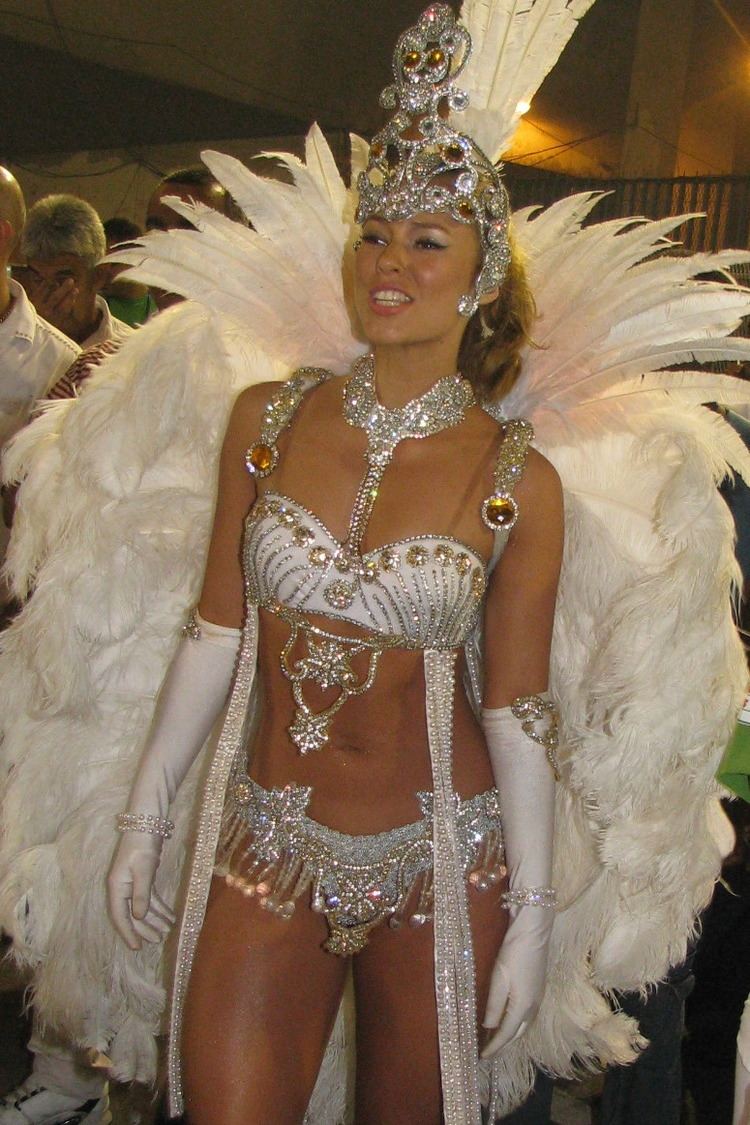 | ||
The Grêmio Recreativo Escola de Samba Acadêmicos do Grande Rio is a samba school of the Special Group of the carnaval of the city of Rio de Janeiro, being headquartered on Almirante Barroso street in Duque de Caxias.
Contents
History
In the 1950s, the city of Duque de Caxias had an effective participation in the Carioca Carnival, with the samba school Cartolinhas de Caxias. This school was placed among the elite of the schools 3 times (1951, 1958 e 1959), posteriorly placed, and frequently, among the intermediate schools and being well respected in the samba world. The last parade of Cartolinhas was in 1971, when with the goal to found a big school, that would worthily represent the municipality of the directors of Grande Rio and Acadêmicos de Caxias, these two schools unified and created in 1988, the Grêmio Recreativo Escola de Samba Acadêmicos do Grande Rio.
The school is very criticized for excessively taking famous people to the avenue and for its excellent results in the judging commission, because of the investments of the patron Jayder Soares and of Milton Perácio, that was the first president of the school.
Like mentioned above, Grande Rio is became specially notorious for bringing famous actresses as Queen of the Drums Sections, called "Rainhas de Bateria". Some of these celebrities below were included over the last years:
Carnavals of Grande Rio
In its starring, in 1989, the school already rose to the next group, passing to the Grupo de Acesso A. In 1990, with the samba-enredo (plot) about the city of Rio de Janeiro, obtained again the 2nd place, and rose to the Special Group. When it starred among the big schools, the school did not go well:with the plot Antes, Durante e Depois: o despertar do homem ("Before, During, and After:the rouse of the man"), the school was placed in the 16th collocation, and returnmed to Grupo de Acesso A, despite to count on people such as the singer Dominguinhos do Estácio and the bateria director Mestre Paulão (consecrated in União da Ilha).
In 1992, the school reconquered the right to compete in the principal parade, being the champion of the Grupo de Acesso, with the plot Águas Claras para um Rei Negro ("Clear Waters for a Black King"). In its return to the Grupo Especial, with the plot No mundo da lua ("In the world of the moon"), of Alexandre Louzada, the school stimulated the Marquês de Sapucaí and was placed in the 9th collocation. In the following years, it did not have good results, but always maintained itself in the Special Group.
The arrival of Max Lopes to Grande Rio, in 1998, made the school obtain again good collocations. With a plot in honor to Luís Carlos Prestes, obtained the 8th collocation; in 1999, homaging Chatô, the school obtained its best collocation until then: 6th place. In 2000, with the Carnaval at sight, talked about the carnavals and the Brazilian parties celebrated for 500 years. A 9th place was not well received by the school, that would already leave an imprint in the Carioca Carnaval.
In 2001, the school brought again a good samba (this time with Quinho), and the star Joãosinho Trinta in command to tell the story of José Datrino. Once again, all complained about the school's 6th place, with no right to parade in the Parade of the Champions. In 2002, did not succeed to return to the Parade of the Champions, because it was placed in the 7th collocation. In 2003, with the plot O nosso Brasil que vale ("Our Brazil that is Worth"), the school of Duque de Caxias, finally succeeded to parade in the Parade of the Champions, with the third place celebrated like it was the title.
In the carnaval of 2004, the school had a bad accomplishment. Bringing a plot about the prevention of the AIDS, everything went bad: some floats were considered immodest and were censured and paraded covered, and even the parade itself was quite drowsy; the only exceptions were the good performance of the bateria and the tune of the community. Result: 10th place and the demmission of Joãosinho Trinta after the parade.
In 2005, the school did again a good parade, with the plot Alimentar o corpo e alma faz bem ("Feeding the body and the soul is good"). Counting on the sponsorship of Nestle, it brought well-built cars, a happy parade, great acting of the bateria, and conquest. Because of that the school was placed, like in 2003, in the third collocation. In the carnaval of 2006, telling the history of the exploration in the Amazon, the Grande Rio conquers its best result: the vice-championship, because it lost two tenths for exceeding the maximum time of parade in 1 minute (what took to the tie in number of points with the school Unidos de Vila Isabel, that won for having better notes in the requirements of tie breaking).
In 2007, the school homaged its city, Duque de Caxias, plot signed by the carnaval producer Roberto Szaniecki (that already signed the carnavals of 1996, 2005, and 2006 of the school). The school conquered its vice-championship for the second time.
For the carnaval of 2008, the school of Duque de Caxias brought to the Sambadrome the importance of the gas in our daily lives, homaging the city of Coari, in Amazonas, that possesses the petrochemical pole of Petrobrás, conquering a third place and finishing with the departure of Roberto Szaniecki after the results.
In 2010, the school took runner up honors in that year's Carnival edition.
